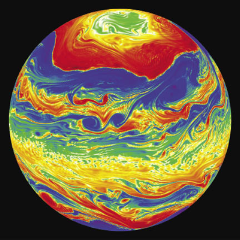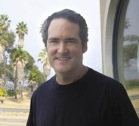If there was one overriding conclusion to be drawn from the KITP pioneering effort to look at “The Physics of Climate Change,” it is “more science needed.”
One is tempted to add “urgently needed,” but the program’s principal organizer, Brad Marston of Brown University, shies away from extremist and exhortative language when talking about climate change, especially in conjunction with isolated catastrophic events such as Hurricane Katrina. “Arguing from a single case is a poor way of reasoning scientifically,” he said.
On the other hand, he notes, “Being told an isolated event can’t be attributed to global warming does not mean that it isn’t. The point is that we can’t reason from one case. We need a pattern; and scientists need to look for patterns, and model them and do everything we do,” said Marston. “It takes time and effort,” he notes, “for a coherent story to emerge.”
Indeed, making a coherent story of the “Physics of Climate Change” program does not work because good stories should have beginnings, middles, and ends. And this program was all about beginnings. It was, in a way, a program about how to have a program on the physics of climate change. Its profoundly exploratory nature signals, perhaps, the emergence of a new physics field.
At the outset of the week-long conference held in conjunction with the more than two months-long program, KITP director David Gross asked the assembled participants how many of them had doctorates in physics. Most raised hands. He then asked how many held appointments in Physics Departments. Few hands rose. It isn’t that these climate physicists can’t get jobs, but that their appointments are in academic departments and institutions other than what is traditionally labeled “physics.”
The program was organized conceptually around three main areas:
(1) Macro-turbulence, pertaining basically to large-scale circulation of Earth’s atmosphere and oceans. Both air and water are fluids though the former changes fast and the latter slowly. An atmospheric example is the Hadley cell, whereby air rises in the tropics, flows towards the poles and descends in the sub-tropics to return towards the equator along a path closer to Earth’s surface than the pole-ward flow. The Gulf Stream, originating in the Gulf of Mexico, and carrying warming water north along the East Coast of the United States before dividing into two currents crossing the Atlantic is an oceanic example.
Macro-turbulence is the most mature of the three conceptual areas around which the program was organized. But, said Marston, “there are still many unanswered big questions,” such as explaining the prediction that as Earth warms the storm tracks will move further towards the poles. That scenario would lead to more drying in the southeast and the southwest of the United States because those places would experience less rain. Large complicated computer models of climate, which have heretofore dominated the science of climate change, show that as Earth warms, storm tracks move away from the equator towards the poles. But why is not well understood, said Marston, and entails addressing “many interesting questions.”
(2) Clouds afford “the largest source of uncertainty in the short-term,” according to Marston. (Article to come next month).
(3) Ecosystems, which change on a time-scale presumably longer than that for clouds, raise the prospect of feedback whose consequences are long-term. Much of the interaction between ecologists and physicists during the program focused on issues related to “feedback.”
Most ecologists participating in the “Physics of Climate Change” program had particular expertise in fire ecology. During the program they conducted a workshop and wrote a paper, rapidly published in “Science” in April 2009, which argued that fire should be understood as a global phenomenon, rather than in a piecemeal, regional fashion, as it has previously been understood. In other words, ecologists have approached fire regimes in terms of specific regions in, say, Australia, South Africa, or California. The KITP working group advocates, instead, a global perspective, which in turn argues for incorporating fire into models of climate change in terms of the cause-and-effect chain reaction of “feedback”– i.e., raging wildfires as both effect and cause of global climate change.
The role ecology plays in global climate change is, of course, broader than the fire-prone ecosystems. For instance, there is the dying off of the piñon forests in New Mexico. Drought stresses the trees and makes them more susceptible to the depredations of pine bark beetles. Most people who study this phenomenon think it is related to climate change, said Marston. “That is the sort of phenomenon that is occurring elsewhere.
“How ecosystems respond to climate change is a big unknown,” he said. “Ecosystems are even more complicated and harder to model than clouds. From the standard physics point of view,” said Marston, modeling ecosystems and incorporating them into models of climate change is “mind boggling. We are really just at the threshold for talking about these questions.”
The program began with a working hypothesis that climate is changing. Said Marston, “We tried to understand how climate is changing and how much and in what ways. But we ended up trying to understand the climate even apart from or as a prelude to understanding what will happen. We still have a long way to go to understand even the current climate: how general circulation works, how clouds function, how ecosystems evolve. I think the key development that has occurred as a result of the program is that types of scientists who have never talked to each other are talking.”
Marston points to his efforts along with physicist colleague Paul Kushner to work with ecologists on feedbacks. “We physicists know the mathematics of feedbacks,” said Marston, “but we don’t really know much about ecosystems.” Marston described hiking with David Bowman, the lead author on the fire ecology “Science” paper, in the Santa Barbara backcountry to survey a small portion of the vast Zaca fire burn-area that blackened some quarter-million acres from July to September 2007. Said Marston of the vista of charred and fledging vegetation, “It just looked like chaos to me. I asked myself, ‘How can we have a quantitative description of this thing?’” But, where Marston saw chaos, he could also see that his companion, Bowman, perceived order.
What happened at the Climate Change program was a meeting of scientific cultures unfamiliar with each other: a meeting between physicists especially the highly theoretical, turbulence types such as Marston and cloud investigator Gregory Falkovich and the empirically-minded ecologists such as David Bowman of the University of Tasmania and Jennifer Balch, a postdoctoral fellow at the National Center for Ecological Analysis and Synthesis. Falkovich, incidentally, returns in 2011 to KITP from his academic position at Israel’s Weizmann Institute to act as organizer of a program “The Nature of Turbulence,” that is, in part, a follow-up to the “Physics of Climate Change” program.
Marston characterizes this meeting of physicists and ecologists as a productive interaction because it showed, he said, that “We can’t really do climate without ecology. It is absolutely primary at least over long time scales. Modelers can hold the ecology fixed, and then ask what happens; but if we scientists really want to know what is going to happen to earth in the next 100 years, we need to worry about how ecosystems are going to change.”
In addition to that deep respect for the relevance of ecology, Marston also pondered at program end whether climate-change research belonged at the KITP. Or, another way of asking that question is “What does theoretical physics have to do with global climate change?” For him and most other participants the short answer is “modeling nature with equations, and then working to solve the equations.”
“That kind of thinking popped up over and over again in the program in terms of what people were doing,” said Marston. Understanding the significance of this effort requires a brief historical digression.
Climate science evolved out of weather forecasting. In fact, models used for climate study could be considered a scaling up of weather forecasting. Initially, weather models were adapted to run a long time without instabilities. Then the models were expanded to incorporate ocean circulation patterns, which represented a big leap because oceans operate on a much different time-scale than does the atmosphere. Climate science, said Marston, has basically been a history of augmenting the models, adding ice, for instance.
Constructing and running these giant models now requires dedicated facilities and vast computational resources. This brute-force computational approach to climate science is akin to high energy physics experiments at accelerator facilities that require teams of experts.
Efforts at KITP, by contrast, focused on constructing a simplified theory and testing it against reduced, but still non-trivial models of, for instance, the jet stream, as Marston and his collaborator Tapio Schneider (a Caltech environmental science professor) have been doing. So, instead of huge simulations of climate that attempt to account for variables, this approach looks for key simplifications that can be modeled. That is the classic physics approach to problem solving, which seeks to identify the key parameter(s).
Marston and Schneider are trying to apply non-equilibrium statistical mechanics to probe climate instead of doing detailed minute-by-minute simulations. They have constructed a toy model of the jet stream flowing east to west along the equator, and then asked various statistical questions such as “what is the mean value of that field?” And “what is its time average?”
Essentially, said Marston, “We pick out some essential feature and throw out everything else.” Such an approach seeks to understand a part thoroughly with the idea of eventually integrating it back into a more complicated model. Another way of describing that step-two effort is “adding layers of complexity to this kind of simple description,” according to Marston. The most important result of this approach, he said, “is that it might recognize or ‘pick out’ fundamental processes, so that we don’t, in effect, lose sight of the forest for all those trees.”
If his speech is any indication, ecology metaphors seem to be shaping Marston’s thought. Of the KITP and its “Physics of Climate Change” program, he said, “This is a planting place for ideas. People go off, and the blooms occur somewhere else.”


